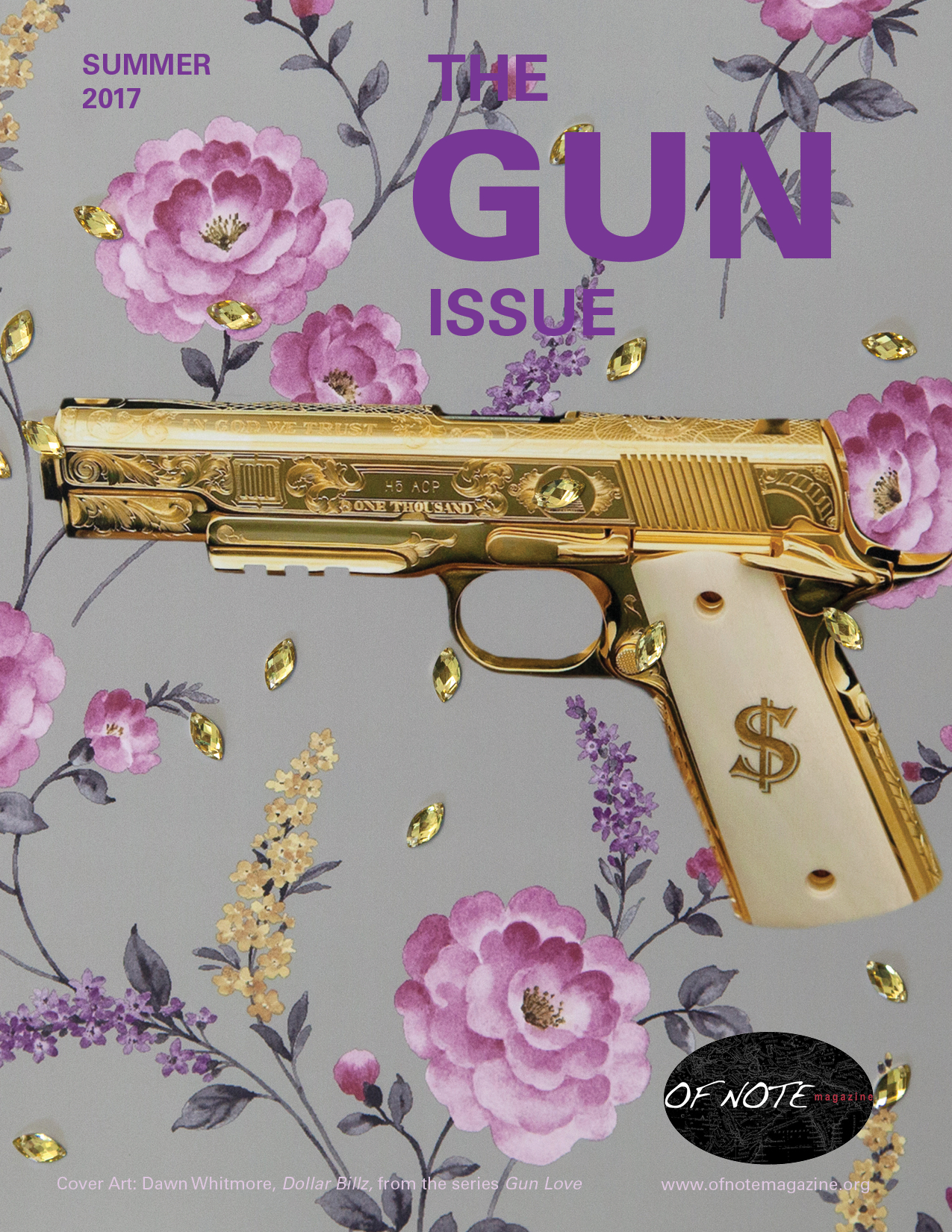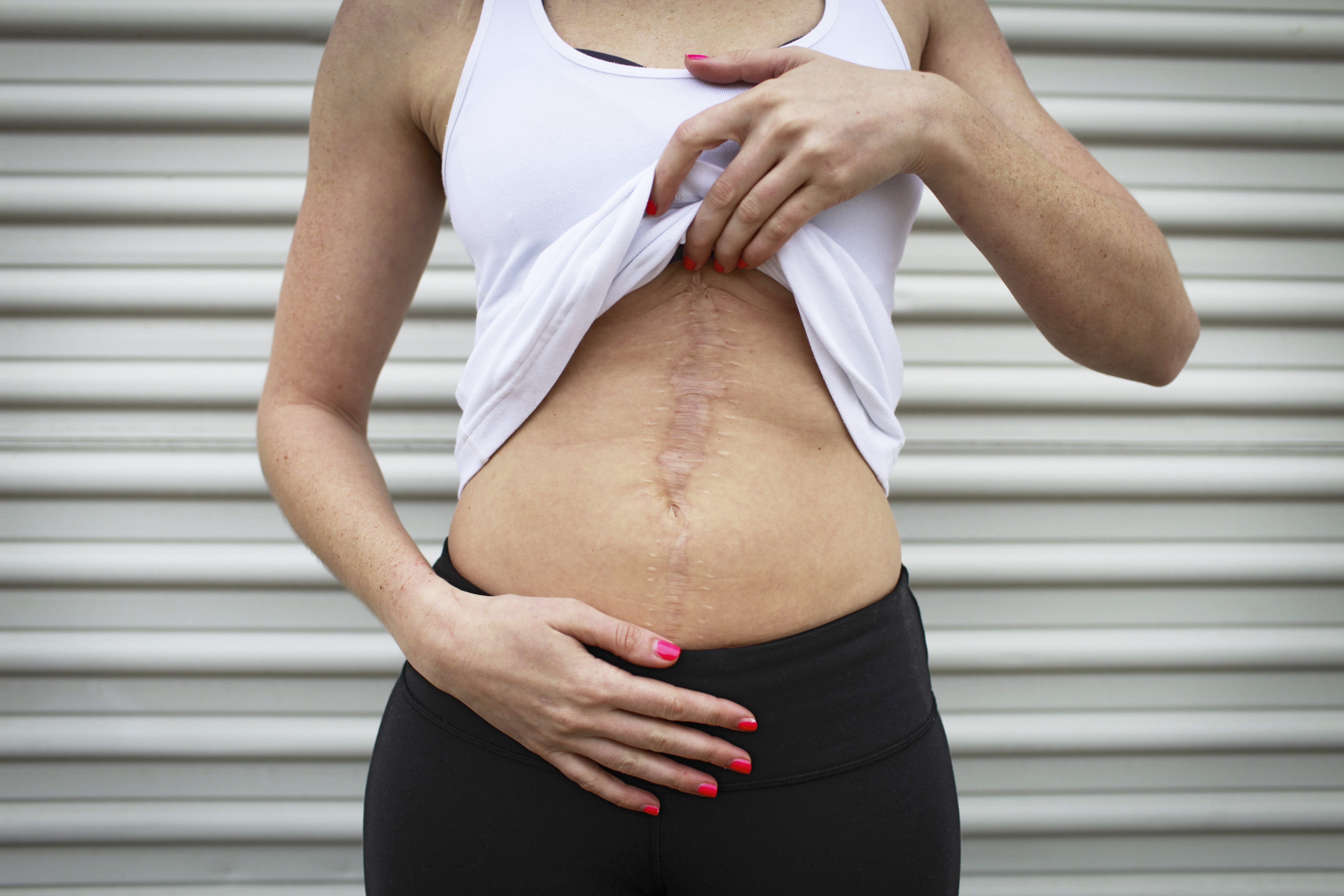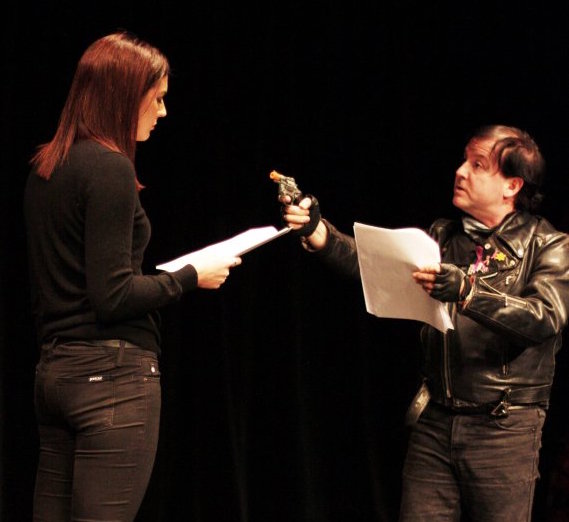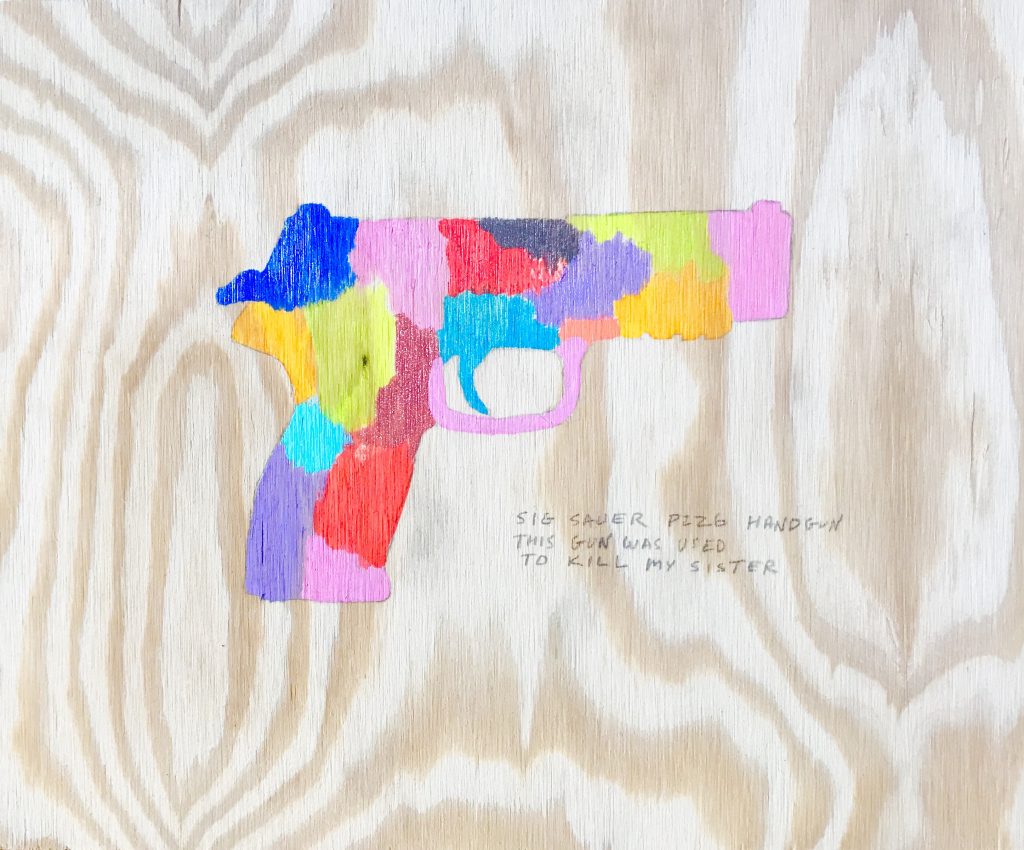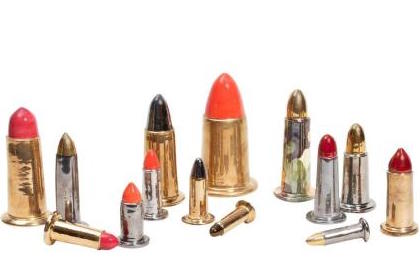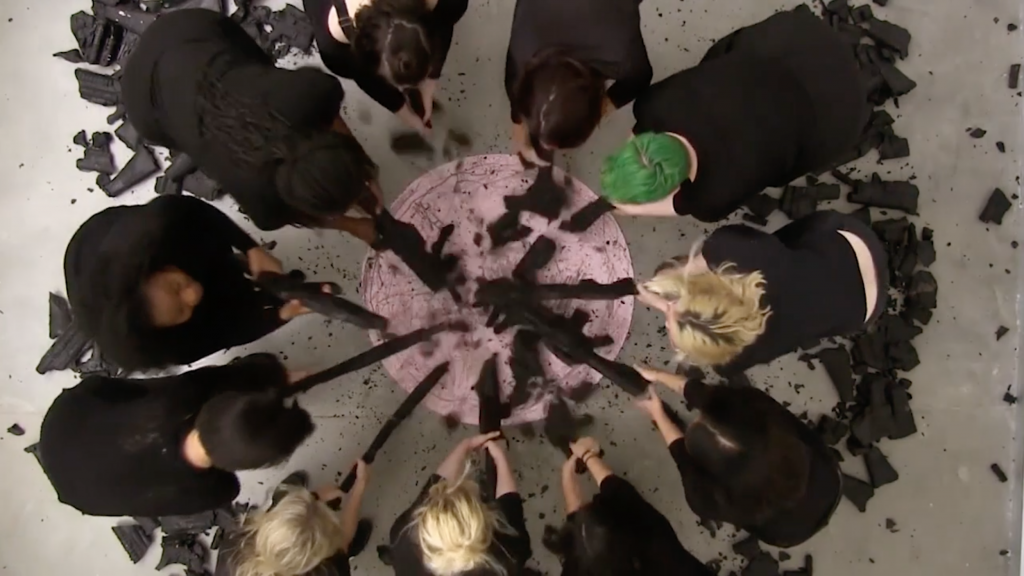The Gun Issue
Support OF NOTE’s work by ordering a Special Print Copy of The Gun Issue.
editorial director’s note
By Grace Aneiza Ali
Gun Violence is a Women’s Issue. Yet, to read the statistics about gun violence in America is to read about a gun culture dominated by men. For women, however, the stakes are just as high—even deadlier. Now, more than ever in our country, gun violence against women and girls has reached new heights. It is undeniably a health crisis. Here’s what the data tells us:
• Women who are victims of domestic violence are 5 times more likely to be killed if their partner owns a gun.
• 80% of people shot to death by intimate partners in the United States each year are women.
• Every 16 hours, an American woman is fatally shot by a current or former intimate partner.
• 44% of mass shootings between 2008 and 2013 in the United States involved the targeting of intimate partners.
• Women are 16 times more likely to die by guns in the U.S. than in any other developed country.
Yet, because a culture of silence pervades gender-based violence, we know that these figures are likely a gross underestimation. As troubling as they are, they have not been enough to shift the dangerous normalization of guns in our culture, even when the statistics prove we have a much higher chance of being hurt by guns than being helped by them.
The 10 multidisciplinary women artists in the OF NOTE’s The Gun Issue engage the gun as an art object in their artistic practices. In doing so, they confront the infiltration of guns in our day-to-day lives—the gratuitous violence meted out by femme fatales in television, film and gaming, the marketing of real pink guns to girls, the faulty narratives equating gun possession with women’s empowerment, and the eroticization and sexualization of the gun-wielding modern woman as the epitome of desire and seduction.
These women artists-activists are mothers invested in the safety of their children. They are wives and girlfriends who survived violent relationships. They are neighbors living in communities ridden with gang violence. They are educators teaching in a time when our nation’s schools and college campuses are hunting grounds plagued by mass shootings. They are citizens living in states where the Second Amendment is the law of the land. And, in cities where the fatigue of police-sanctioned violence on people of color has become all too unbearable.
Some of the women know intimately the pain a gun inflicts, its visible and invisible trauma, and have borne witness to how gun violence rips families apart. Some have been on the receiving end of gun violence by their own intimate partners. Not all of them have reported these experiences, turning instead to their artwork and a community of women, not the police. Others have experienced the fear of having looked down the barrel of a gun in random acts of violence. Some are responsible gun owners. Then there are those who’ve never touched a gun, but whose stories of the befallen haunt them.
Collectively, these artists are reclaiming the gun from a weapon of destruction into a tool of resistance. To do so they engage the art of poetry, theater, photography, sculpture, performance, and painting, among other mediums. Their artwork strips the gun bare of its power, repurposes it, and in some cases their artmaking involves its literal dismantling and destruction. Their work forces us to confront the unpretty—the damage done to a woman’s body after a gunshot wound. It also generously offers women platforms to share their narratives of survival. In the process, these women are shifting the conversations around gun violence.
At times their work is boldly political, at times they are meant to change hearts and minds. Equally beautiful, these artists use their work to shine a light on one courageous woman/survivor/resistor/disruptor after another—reminding us to trust in the power of women.
Featured Articles
BY GRACE ANEIZA ALI
In her provocative photography project Gun Love, Washington, D.C.-based photographer and visual artist Dawn Whitmore transforms weapons of destruction into objects of desire. Encased in gold, bejeweled, bedazzled, imprinted with Hello Kitty stickers, adorned with a breast cancer ribbon, designed with floral prints, embossed with the Louis Vuitton logo, or simply bathed in bright pink, these decorated firearms, intentionally manufactured and marketed for their “feminine mystique,” are a striking commentary on a troubling American gun culture and the modern woman.
Kathy Shorr: SHOT: Survivors of Gun Violence in America
BY STEPHANIE SEGUINO
In a project that spanned more than two years, Kathy Shorr photographed 101 survivors of gun violence in the same location in which they were shot—in the Walmart parking lot, in their own homes, in their cars, walking through Times Square. Some of Shorr’s subjects are survivors of domestic violence, others responsible gun owners themselves. Their portraits demonstrate that no racial/ethnic group, no part of the country, no age group is spared when it comes to gun violence.
..
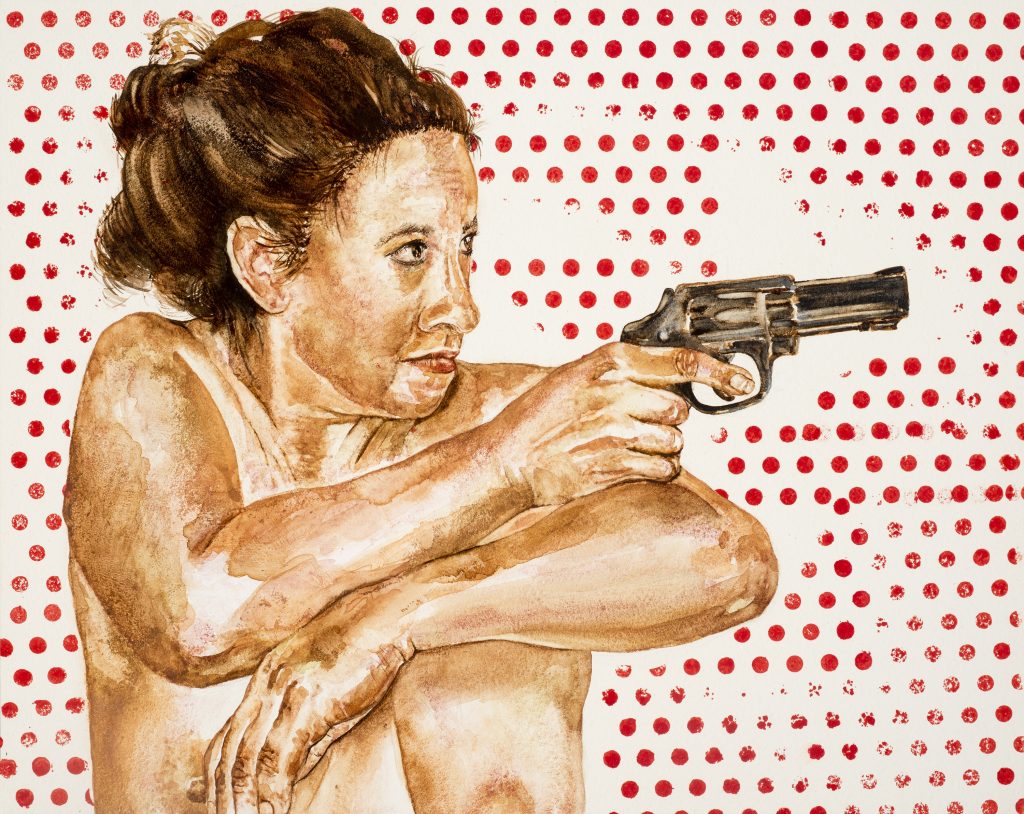 Rosemary Meza-DesPlas: The Dangerous Seduction of Women with Guns
Rosemary Meza-DesPlas: The Dangerous Seduction of Women with Guns
BY BERETTE MACAULAY
The Hollywood femme fatale archetype—thin, white, scantily clad, and holding a gun—permeates our media from films to video games. Rosemary Meza-DesPlas asks us to consider the potential harm of such a widely disseminated image. In her series Chicks with Guns, Meza-DesPlas worked with full figured models to produce her heroine paintings, keeping them naked, posing them uncomfortably, and rejecting the prescribed sexy femme entirely. These women challenge us to consider the normalized Hollywood image as absurd, to examine not only what entertainment media dramatizes, but also what it omits.
 Montana Ray: The Concrete Poems of (guns & butter)
Montana Ray: The Concrete Poems of (guns & butter)
BY STACY PARKER LE MELLE
The “pretty gun” on the cover of poet Montana Ray’s (guns & butter) seduces you to open the book and encounter more guns. But this time, they are poems shaped as guns, and they are complicated works of art. In this collection, Ray creates both literary and visual art with her concrete poems, a form of poetry where the shape of words on the page construct meaning. Ray’s poems contain many truths at once, especially when juxtaposed with her printed recipes—the “butter” of the book, sustenance that can be nourishing or bloating, depending on your intake.
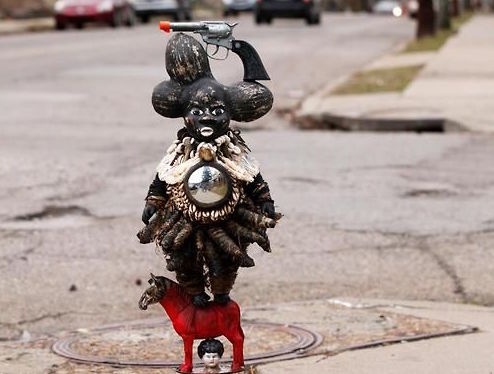 Vanessa German: “Power Figures” Armed With A Mantra for Justice
Vanessa German: “Power Figures” Armed With A Mantra for Justice
BY JAIMEE SWIFT
Inspired by an Africana aesthetic, multidisciplinary artist Vanessa German celebrates the strength, lives, and overall essence of Black women and girls through her powerful visuals, sculptures, and artistry. With ArtHouse, an artistic sanctuary she founded in Homewood, Philadelphia for children and neighborhood folks to thrive amidst a city plagued with gun violence, German’s work is the epitome of what she calls “citizen artistry.”
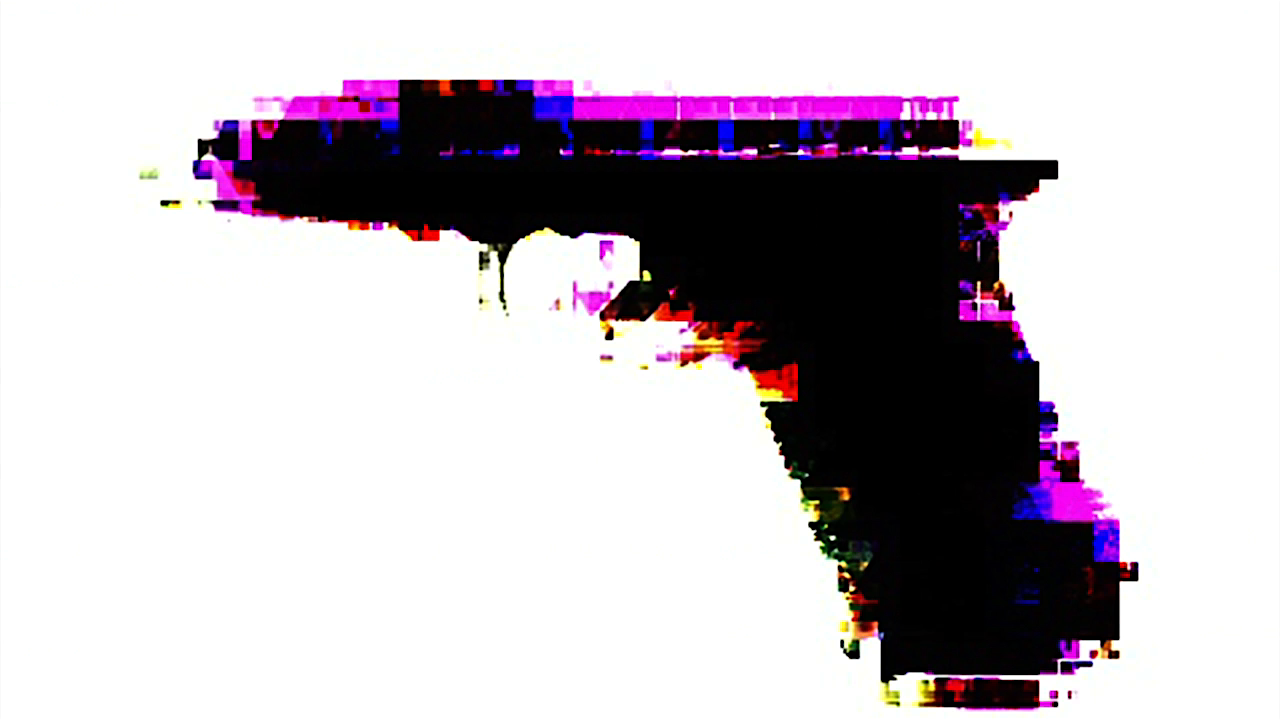 Jessica Fenlon: Deconstructing Gun Speech, Silence, & Beliefs
Jessica Fenlon: Deconstructing Gun Speech, Silence, & Beliefs
BY APRIL GREENE
After a single weekend in which 14 people were killed with guns in Chicago, visual artist Jessica Fenlon began collecting digital images of gunsfrom all over the internet and “breaking” each one through a process she calls “glitch sabotage.” The result was a six-and-a-half-minute video titled ungun. In addition to the goal of “breaking” guns visually, Fenlon wanted ungun to break apart and re-envision the beliefs we hold about guns, whatever they are.
Caridad Svich: Gun Violence Takes Center Stage
BY BUREEN RUFFIN
For Obie Award winning playwright Caridad Svich, the theatre community is a generous space where artists can come together and create art that responds to the issues most important to human beings. In 2012, she co-launched the Gun Control Theatre Action (GCTA) in Washington, D.C., New York City, Los Angeles, Seattle, Chicago, Sydney, and more. The new plays took on the issue of gun control and gun violence fearlessly and unflinchingly, asking audiences to witness, reflect, and think critically about their own accountability in the culture of guns in the United States.
Kadie Salfi: Guns of Mass Destruction
BY KATIE BEETON
Through SNAFU, a collection of life-size replicas of the guns used in American mass shootings from 1966 to present, where five or more people were killed, Kadie Salfi explores our country’s troubled relationship with guns. She symbolizes each shooting via a life-size painting of the gun used to commit the act, emphasizing, through the repetition of form, the ubiquity of guns in America. In presenting the gun over and over again as a work of art, Salfi shows how the object functions as a politically-charged weapon.
Linda Lighton: ‘Taking Aim’ on Gun Culture
BY MACKENZIE LEIGHTON
For the past seven years, ceramic artist Linda Lighton has been producing social commentary on gun violence and its presence in her Kansas City community. Lighton’s sculptures often explore feminine sexuality, and her work on gun violence embraces the phallicism of the weapons to further incorporate gender into the conversation. Through Lighton’s work, we are forced to question the presence of guns in our everyday lives versus that of our country as a whole.
Jessica Pleyel: Standing To(get)her Against Guns
BY REBECCA OLSON
Performance artist Jessica Pleyel’s To(get)her project is a collaborative art piece in which women who’ve experienced violent trauma use commonplace domestic objects to dismantle wax guns through cathartic acts of destruction. To(get)her seeks to create an empowering experience for its participants, while simultaneously raising awareness about gun violence against women. The project’s clever name communicates this sense of unity and understanding–while also alluding to the threat of danger.

